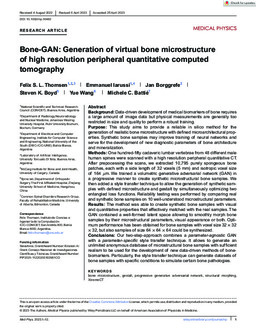Mostrar el registro sencillo del ítem
Bone-GAN: Generation of virtual bone microstructure of high resolution peripheral quantitative computed tomography
| dc.rights.license | https://creativecommons.org/licenses/by-sa/2.5/ar/ | es_AR |
| dc.contributor.author | Iarussi, Emmanuel | es_AR |
| dc.contributor.author | Thomsen, Felix S. L. | es_AR |
| dc.contributor.author | Borggrefe, Jan | es_AR |
| dc.contributor.author | Boyd, Steven K. | es_AR |
| dc.contributor.author | Wang, Yue | es_AR |
| dc.contributor.author | Battié, Michele C. | es_AR |
| dc.date.accessioned | 2023-06-05T19:23:35Z | |
| dc.date.available | 2023-06-05T19:23:35Z | |
| dc.date.issued | 2023 | |
| dc.identifier.uri | https://repositorio.utdt.edu/handle/20.500.13098/11858 | |
| dc.identifier.uri | https://doi.org/10.1002/mp.16482 | |
| dc.description.abstract | Background:Data-driven development of medical biomarkers of bone requires a large amount of image data but physical measurements are generally too restricted in size and quality to perform a robust training. Purpose: This study aims to provide a reliable in silico method for the generation of realistic bone microstructure with defined microarchitectural properties. Synthetic bone samples may improve training of neural networks and serve for the development of new diagnostic parameters of bone architecture and mineralization. Methods: One hundred-fifty cadaveric lumbar vertebrae from 48 different male human spines were scanned with a high resolution peripheral quantitative CT. After prepocessing the scans, we extracted 10,795 purely spongeous bone patches, each with a side length of 32 voxels (5 mm) and isotropic voxel size of 164 𝜇m. We trained a volumetric generative adversarial network (GAN) in a progressive manner to create synthetic microstructural bone samples. We then added a style transfer technique to allow the generation of synthetic samples with defined microstructure and gestalt by simultaneously optimizing two entangled loss functions. Reliability testing was performed by comparing real and synthetic bone samples on 10 well-understood microstructural parameters. Results: The method was able to create synthetic bone samples with visual and quantitative properties that effectively matched with the real samples. The GAN contained a well-formed latent space allowing to smoothly morph bone samples by their microstructural parameters, visual appearance or both. Optimum performance has been obtained for bone samples with voxel size 32 × 32 × 32, but also samples of size 64 × 64 × 64 could be synthesized. Conclusions: Our two-step-approach combines a parameter-agnostic GAN with a parameter-specific style transfer technique. It allows to generate an unlimited anonymous database of microstructural bone samples with sufficient realism to be used for the development of new data-driven methods of bonebiomarkers. Particularly, the style transfer technique can generate datasets of bone samples with specific conditions to simulate certain bone pathologies. | es_AR |
| dc.description.sponsorship | Este artículo se encuentra publicado en Medical Physics, (Junio 2023) | es_AR |
| dc.format.extent | pp. 1-12 | es_AR |
| dc.format.medium | application/pdf | es_AR |
| dc.language | eng | es_AR |
| dc.publisher | Medical Physics | es_AR |
| dc.publisher | American Association of Physicists in Medicine | |
| dc.relation.ispartof | Medical Physics 2023;1-12. | |
| dc.rights | info:eu-repo/semantics/openAccess | es_AR |
| dc.subject | Bone microstructure | es_AR |
| dc.subject | Gestalt | es_AR |
| dc.subject | Progressive generative adversarial network | es_AR |
| dc.subject | Structural morphing | es_AR |
| dc.subject | XtremeCT | es_AR |
| dc.title | Bone-GAN: Generation of virtual bone microstructure of high resolution peripheral quantitative computed tomography | es_AR |
| dc.type | info:eu-repo/semantics/article | es_AR |
| dc.type.version | info:eu-repo/semantics/publishedVersion | es_AR |
Ficheros en el ítem
Este ítem aparece en la(s) siguiente(s) colección(ones)
-
Artículos presentados, aceptados y publicados
Publicaciones de investigadores ditellianos en revistas científicas

